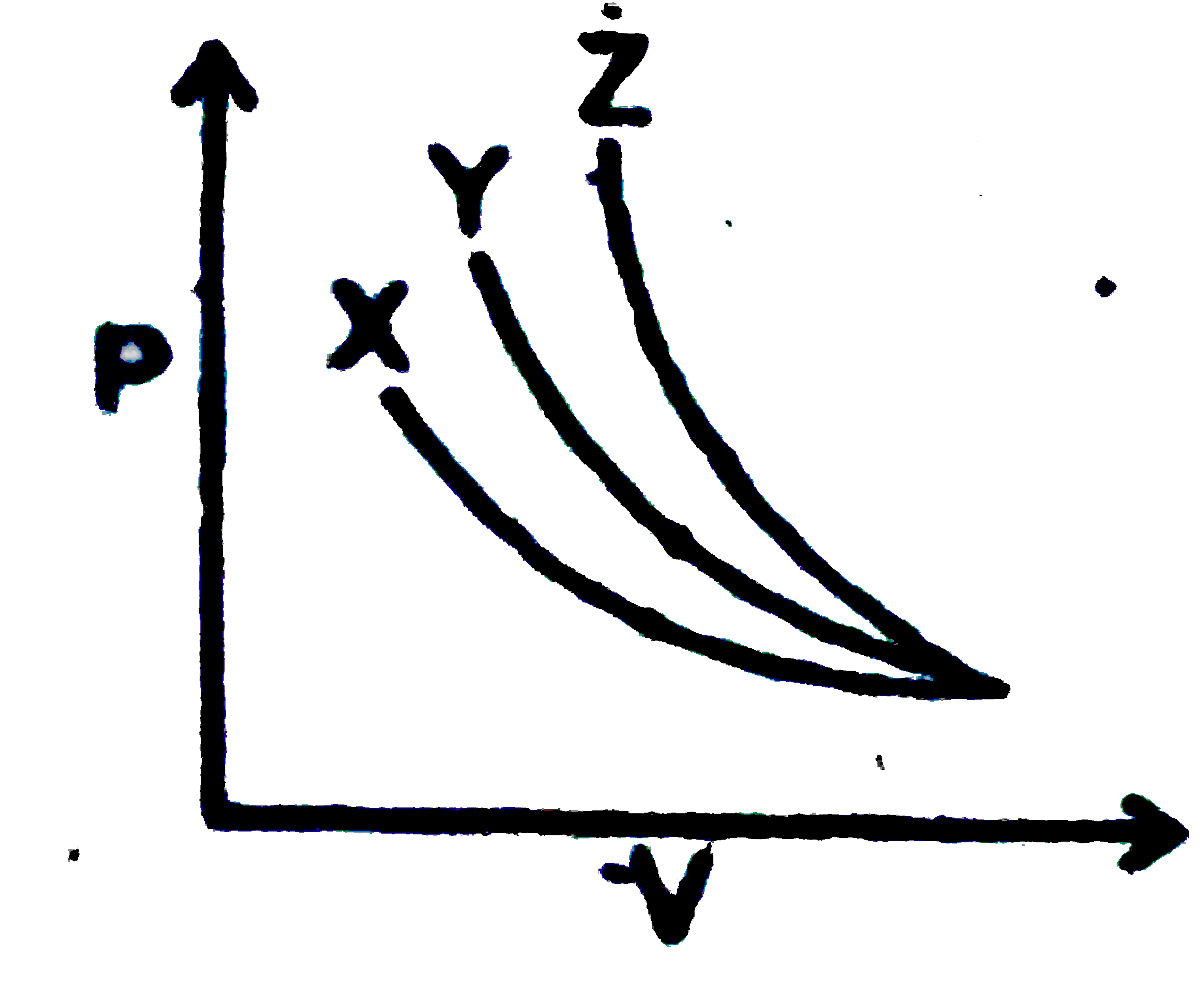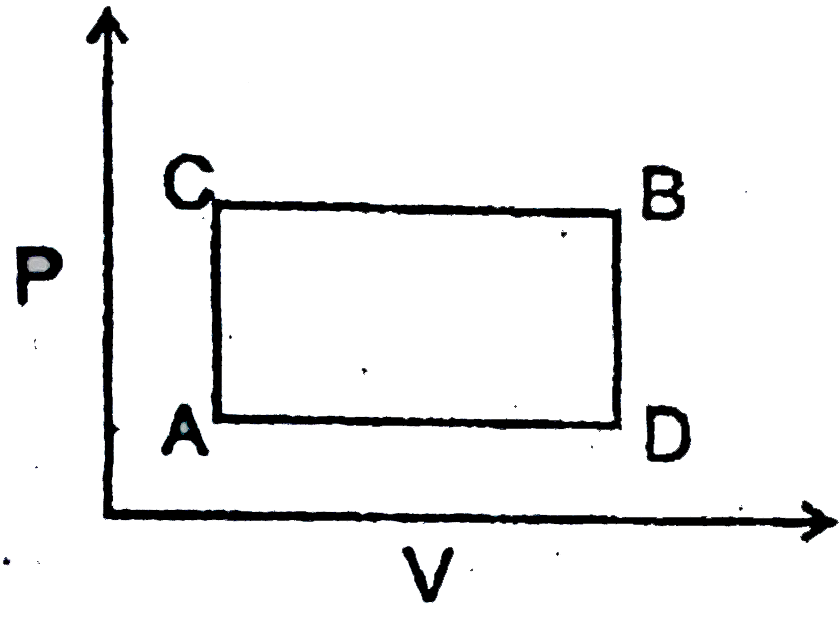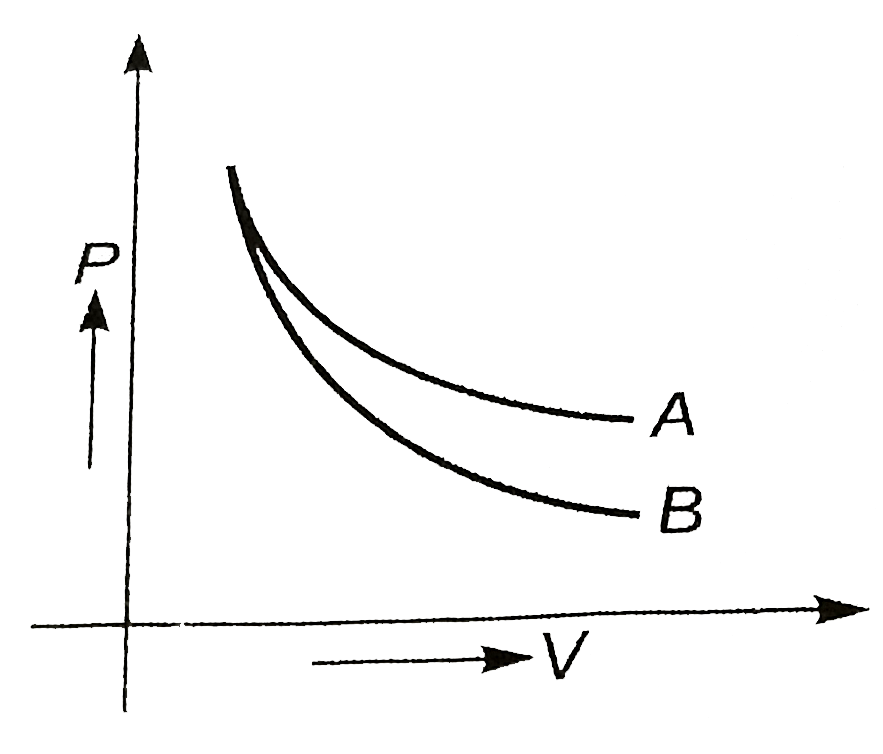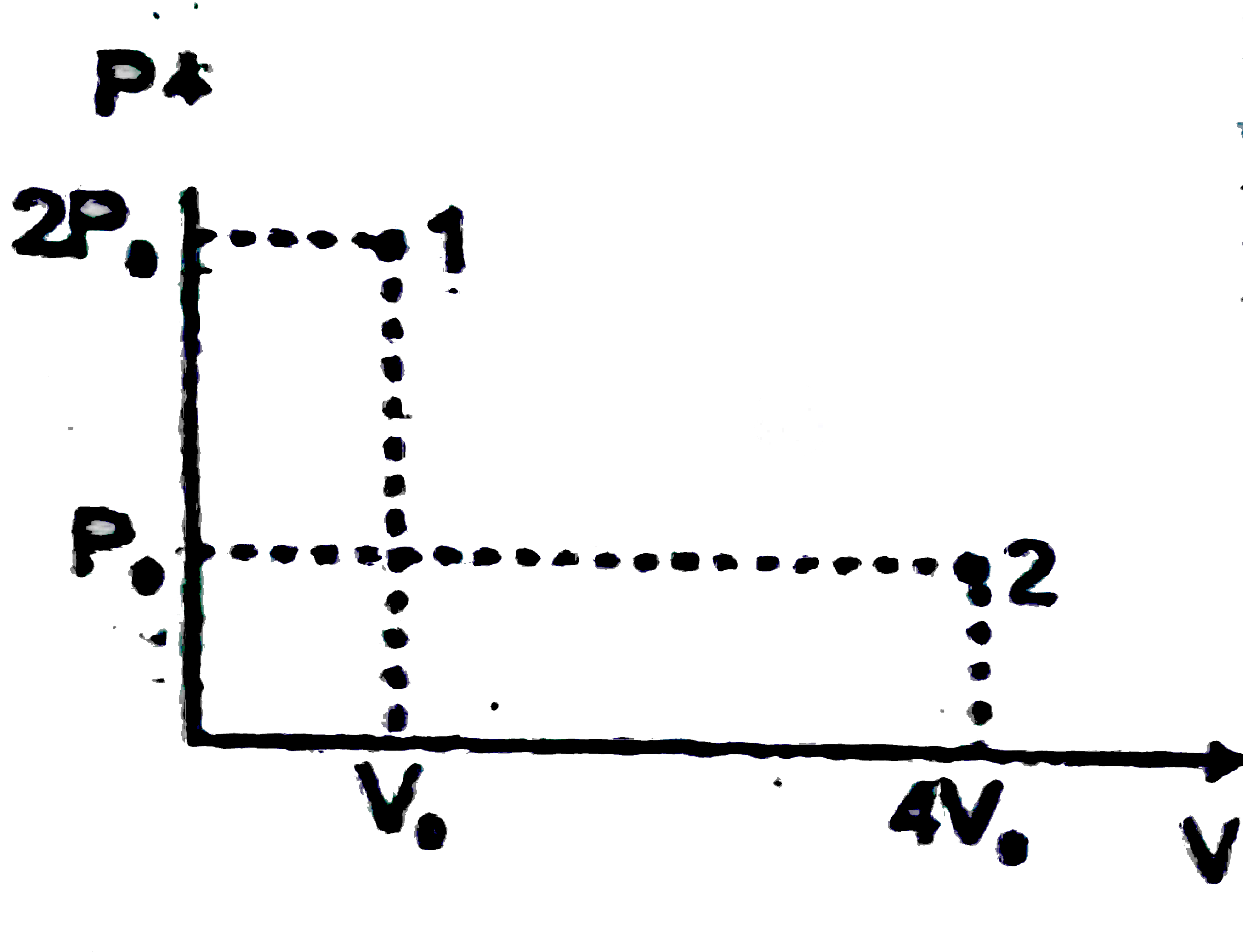Complete Solutions to PHYSICAL CHEMITRY (THERMODYNAMIC & THERMOCHEMISTRY) of chapter THERMODYNAMIC & THERMOCHEMISTRY of Class 11 book with complete answers and questions
| Class 11 | CHEMISTRY |
| Chapter | THERMODYNAMIC & THERMOCHEMISTRY |
| RESONANCE | PHYSICAL CHEMITRY (THERMODYNAMIC & THERMOCHEMISTRY) |
| Number Of Questions | 62 |
| Academic Year | 2023-24 |
Heat of atomisation of `NH_3 and N_2H_4 ` are `x kcal mol^(-1)` respectively. Calculate average bond energy of N - N bond.
View SolutionFor the reaction at `25^(@)C, C_(2)O_(4)(l) rarr 2XO_(2)(g)`
`Delta H =2.1 kcal` and `DeltaS=20 cal K^(-1)` . The reaction would be `:`
View SolutionIf one mole of an ideal gas `(C_(p,m)=(5)/(2)R)` is expanded isothermally at 300 K until it's volume is tripled, then change in entropy of gas is :
View Solution`P-V` plts for the gases ( assuming ideal behaviour and similar condition ) for reversible adiabatic compression are given in the figure below `:`
Plots `X,Y` and `Z` should correspond to respectively `:`

View SolutionAn ideal gas at initial pressur e`P_(1)` and volume `V_(1)` undergoes reversible expansion to the same volume `V_(f)` either isothermally or adiabatically . Consider the following statements `:`
1. `|P_(f)(` adiabatic `) lt P_(f)(` isothermal `)|" "` 2. `|W(` adiabatic `) |lt|W(` isothermal `)|`
3. `|T_(f)(` adiabatic `) lt T_(f)(` isothermal `)|" "` 4. `|q(` adiabatic `)|lt|q(` isothermal `)|`
where the symbols have their usual meaning.
How many statements of the above are correct?
View SolutionWhen a system is taken from state `B` to state `A` along path `BDA` as shown in figure below, `60 J` of heat flows out of the system and `10J` of work is doen on path `ACB` , then the heat corresponding to the processes `AC` and `BC` is respectively.

View SolutionIn a system, a piston caused an external pressure of `1.25` bar giving a change in volume of `32 L` for which, `Delta E=-51KJ`. What was the value of heat involved`:`
View SolutionIf 1 mole of an ideal gas expands isothermally at `37^(@)C` from 15 litres to 25 litres, the maximum work obtained is `:`
View SolutionTwo moles of an ideal gas undergo the following process `:`
`(a)` a reversible isobaric expansion from `( P` atm, `V L)` to `( P` atm , `2V L)`.
`(b)` a reversible isochoric change of state from `( P` atm , `2V,L)` to `(P//2` atm, `2V L)`
`(c )` a reversible isothermal compression from `(P//2` atm, `2V L)` to `(P ` atm, `V L)`.
Sketch with labels each of the processes on the same `P-V` diagram.
View SolutionWhat are the signs of the entropy change `( +` or `-)` in the following`:`
`I.` A liquird crystallisation in to solid
`II.` Temperature of solid raised from 0 to 115K
`III.` `2 NaHCO_(3)(s) rarr Na_(2)CO_(3)(s)+CO_(2)(g)+H_(2)O(g)`
`IV.` `H_(2)(g) rarr 2H(g)`
View SolutionIf `HA+NaOH rarr NaA+H_(2)O" "DeltaH=-12kcal`
and `HB+NaOH rarr NaB+H_(2)O" " DeltaH=-11kcal`
then equimolar solution of which acid has higher `pH :`
View SolutionA reaction has `DeltaH=-33 kJ` and `DeltaS=-58 J//K`. This reaction would be:
View SolutionIn the isothermal reversible compression of `52.0m` mol of a perfect gas at `260 K`, the volume of the gas is reduced to one`-`third of its initial value. Calculate `w` of this process.
View SolutionA child bought a balloon which became very small in size the next day. Which is correct statement about balloon?
View SolutionIt the following processes, identify the irreversible process `:`
View SolutionIf bond energy of `H_(2),F_(2)` and `HF` are in the ratio `2:1:3` and `DeltaH_(a)(H_(2))=400kJ//mol`. Then `DeltaH_(f)(HF)` is `:`
View SolutionOne mole of a non-ideal gas undergoes a change of state from (1.0 atm, 3.0 L, 200 K) to (4.0 atm, 5.0 L, 250 K) with a change in internal energy `(DeltaU) = 40 ` L-atm. The change in enthalpy of the process in L-atm :
View SolutionCalculate the final pressure of a sample of carbon dioxide that expands reversibly and adiabatically from `57.4kPa` and `1.0` to a final volume of `2.0L` . Take `gamma = 1.4`
View SolutionThe heat evolved from the combustion of carbon is used to heat water. Assuming `50%` efficiency, calculate mole of water vaporized at its boiling point `Delta H_(f)=(CO_(2))=-94K cal//mol` and `DeltaH_(vap)(H_(2)O)=9.6kcal //mol)` and `6g C` is undergoing combustion
View SolutionThe equilibrium constant for
`A(g)+B_(2)(g) hArr AB_(2)(g)" "k_(p)=100` at `522K`.
Structure of `AB_(2)` is like `H_(2)O` . If bond energy of `A-B` bond is `200 kJ//mol` and that of `B-B` bond is `100 kJ//mol,` the find `Delta S^(@)` of the above reaction `:`
View SolutionWhen `1L` of `NaOH(1M)` is mixed with `1L` of `HCl(1M)` the temperature of reaction mixture rises by `10^(@)C` . When `1L` of `NaOH(1M)` is mixed with `2L(0.5M)HCl`, the temperature of reaction mixture rises approximately by `:`
View Solution`2Fe + 3/2 O_2 rarr Fe_(2)O_(3) " "xkJ//"mole"`
`2Fe + O_(2) rarr 2FeO " "ykJ//"mole"`
The to form one mole of Fe3O4 from Fe and `O_2` is :
View SolutionThe species which by definition has zero standard molar enthalpy of formation at `298K` is
View SolutionIn which of the following changes at constant pressure, is work done by system on surrounding ?
View SolutionOne gram of an organic liquid X (molecular mass 78) liberates 160 J of heat on solidification. `Delta H_("fusion")(X)` is :
View SolutionBond energies are equal to dissociation energies in case of :
View Solution`S (rhombic) + O_(2)(g) rightarrow SO_(2)(g), Delta H = -297.5 kJ`
`S(monoclinic) + O_(2) (g) rightarrow SO_(2)(g), Delta H = -300 kJ`
The above data can predict that
View SolutionA system absorbs 300 cal. Of heat, its volume doubles and temperature rises from 273 to 298 K, the work done on the surrounding is 200 cal `DeltaE`, for the above reaction is
View SolutionIn which of the following changes, `Delta H` is always negative :
View SolutionCalculate the enthalpy change when `50 mL` of `0.01 M Ca(OH)_(2)` reacts with `25mL` of `0.01 M HCI`. Given that `DeltaH^(Theta)` neutralisaiton of strong acid and string base is `140 kcal mol^(-1)`
View SolutionCalculate difference between `DeltaH` and `DeltaU` when 1 mole of grey tin `(` density `=5.75g//cm^(3))` changes to white tin `(` density `=7.31g//cm^(3))` at 10 bar . ( at `298 K, DeltaH=+2.1 kJ,` at `wt=119` of `Sn)`
View SolutionTemperature of `1mol` of a gas is increased by `1^(@)` at constant pressure. The work done is
View SolutionA sample of oxgyen gas expands its volume from 3 L to 5 L against a constant pressure of 3 atm. If work done during expansion to used to heat 10 mole of water initially present at 290 K, its final temperature will be (specific heat capacity of water = 4.18 J//K-g)
View SolutionAt `0^(@)C,DeltaH_(fus)^(@)=6kJ //mol`, change of entropy for freezing of one mole of ice will be `:`
View SolutionAt `27^(@)C,N_(2)O_(4)` has vapour density`=(230)/(6)`. If the equilibrium pressure is `0.96 atm`, then find `DeltaG^(@)`. ( given `log2 =0.3)`
View Solution`DeltaS=(q_(rev))/(T)`, so
View SolutionA `10g` piece of iron `( C =0.45 J//g^(@)C )` at `100^(@)C` is dropped into `25g` of water `( C =4.2 J//g^(@)C)` at `27^(@)C`. Find temperature of the iron and water system at thermal equilibrium .
View SolutionAn ideal gas expands against a constant external pressure of 2.0 atmosphere from 20 litre to 40 litre and absorbs 10 kJ of heat from surrounding. What is the change in internal energy of the system? (Given : 1 atm-litre = 101.3 J)
View SolutionFor a closed container containing 100 mole of an ideal gas fitted with movable, frictionless, weightless piston operating such that pressure of gas remains constant at 8.21 atm. Which graph represents correct variation of log V vs. log T where V is in litre and T in kelvin?
View Solution10 mole of ideal gas expand isothermally and reversibly from a pressure of 10 atm to 1atm at 300 K. What is the largest mass which can lifted through a height of 100 meter?
View SolutionWhat is the final temperature of 0.10 mole monoatomic ideal gas that performs 75 cal of work adiabatically if the initial temperature is `227^(@)C` (use R = 2 cal/K-mol)
View SolutionDuring an adiabatic process, the pressure of a gas is found to be proportional to cube of its absolute temperature. The poision's ratio of gas is:
View SolutionP-V plot for two gases (assuming ideal) during adiabatic processes are given in the Fig. Plot A and plot B should correspond respectively to:

View SolutionCalculate the final temperature of a monoatomic ideal gas that is compressed reversible and adiabatically from `16L` to `2L` at `300 K :`
View SolutionCalculat average molar heat capacity at constant volume of gaseous mixture contained 2 mole of each of two ideal gases `A (C_(v,m)=(3)/(2)R)` and `B (C_(v,m)=(5)/(2)R)` :
View SolutionConsider the reaction at 300 K
`C_(6) H_(6) (l)+(15)/(2)O_(2)(g)rarr6CO_(2)(g)+3H_(2)O(l), DeltaH = - 3271 kJ`
What is `DeltaU` for the combustion of 1.5 mole of benzene at `27^(@)C` ?
View SolutionAt `5 xx 10^(5)` bar pressure density of diamond and graphite are `3 g//c c` and `2g // c c` respectively, at certain temperature 'T'. Find the value of `DeltaU - DeltaH` for the conversion of 1 mole of graphite to 1 mole of diamond at temperature 'T' :
View SolutionPredict which of the following reaction(s) has a positive entropy change?
I. `Ag^(+)(aq)+Cl^(-)(aq)rarrAgCl(s)`
II. `NH_(4)Cl(s) rarrNH_(3)(g) +HCl(g)`
III. `2NH_(3)(g) rarr N_(2)(g)+3H_(2)(g)`
View SolutionWhat is the change in entropy when 2.5 mole of water is heated from `27^(@)C` to `87^(@)C`? Assume that the heat capacity is constant. `(C_(p,m)(H_(2)O)=4.2J//g-K" and "ln (1.2) = 0.18)`
View SolutionCalculate standard entropy change in the reaction
`Fe_(2)O_(3)(s) +3H_(2)(g)rarr2Fe(s) +3H_(2)O(l)` Given : `S_(m)^(@) (Fe_(2)O_(3),S)= 87.4,S_(m)^(@) (Fe,S)=27.3,`
`S_(m)^(@)(H_(2),g)=130.7,S_(m)^(@) (H_(2)O,l)=69.9JK^(-1)mol^(-1)`
View SolutionFor isothermal expansion in case of an ideal gas :
View SolutionThe standard enthalpy of formation of octane `(C_(8)H_(18))` is `-250` kJ/mol. Calculate the enthalpy and `-286` kJ/mol of `C_(8)H_(18)`. The enthalpy of formation of `CO_(2)(g)` and `H_(2)O(l)` are `-394` kJ/mol and `-286` kJ/mol respectively :
View SolutionCalculate P-Cl bond enthalpy
Given : `Delta_(f)H(PCl_(3),g)=306 " kJ"//"mol, "DeltaH_("atomization")(P , s) =314 " kJ"//"mol",`
`Delta_(f)H(Cl,g)=121 " kJ"//"mol"`
View SolutionOne gram equivalent of a weak acid is unable to completely neutralise one gram equivalent of a strong base.
View SolutionEthyl chloride `(C_(2)H_(5)Cl)` , is prepared by reaction of ethylene with hydrogen chloride`:`
`C_(2)H_(4)(g)+HCl(g) rarr C_(2)H_(5)Cl(g)`
`DeltaH=-72.3kJ//mol`
What is the value of `DeltaE (` in `kJ)`, if `98g` of ethylene and `109.5g` of `HCl` are allowed to react at `300K`
View Solution`NH_(3)(g) + 3Cl_(2)(g) rarr NCl_(3)(g) + 3HCl(g), " "DeltaH_(1)`
`N_(2)(g) + 3H_(2)(g) rarr 2NH_(3)(g), " "Delta H_(2)`
`H_(2)(g) + Cl_(2)(g) rarr 2HCl(g), " "Delta H_(3)`
The heat of formation of NCl3(g) in the terms of `DeltaH_(1), DeltaH_2 and DeltaH_(3)` is :
View SolutionCalculate the entropy change when `3.6g` of liquid water is completely converted into vapour at `100^(@)C` . The molar heat of vaporization is `40.85KJ mol^(-1)` .
View SolutionThe molar entropy content of `1 ` mole of oxygen `(O_(2))` gas at `300 K` and `1 atm` is `250 J mol e^(-1)K^(-1)`. Calculate `DeltaG` when 1 mole of oxygen is expanded reversibility and isothermally from `300K`, 1 atm to double its volume ( Take `R=8.314J mol e^(-1)K^(-1),log e=2.303)`
View SolutionHow many of the given statement are correct `:`
`I :` Molar entropy of a substance follows the order `(S_(m))_("Solid")lt (S_(m))_("liquid")lt(S_(m))_("gas")`
`II :` Entroy change of system for the reaction `H_(2)(g) rarr 2H(g) `is `+ve`.
`III. ` Molar entropy of a non`-` crystalline solid will be zero at absolute zero.
`IV :` If the path of an irreversible process is reversed, then both system and surrounding shall be restored to their original states.
`V: ` Refractive index and molarity are intensive properties.
View SolutionOne mole of an ideal monoatomic gas at `27^(@)C` is subjected to a reversible isoentropic compression until the temperature reached to `327^(@)C`. If the initial pressure was `1.0 atm`, then find the value of ln `P_(2)`
`(` Given `: ln 2=0.7)`
View SolutionA liquid which is confined inside an adiabatic piston is suddently taken from state `-1` to state `-2` by a single stage irreversible process. If the piston comes to rest at point 2 as shown, then the enthalpy change for the process will be `:`

View SolutionP-V plot for two gases (assuming ideal) during adiabatic processes are given in the Fig. Plot A and plot B should correspond respectively to:

View Solution
PHYSICAL CHEMITRY (THERMODYNAMIC & THERMOCHEMISTRY) questions and complete solutions for chapter THERMODYNAMIC & THERMOCHEMISTRY of RESONANCE ENGLISH of Class 11